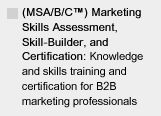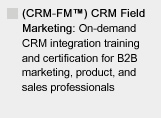MAKE SURE YOU CONTINUE TO RECEIVE EACH ISSUE OF TUESDAY MARKETING NOTES—CLICK HERE TO RENEW YOUR FREE SUBSCRIPTION
Six Steps to Developing the Measurability Mindset: Building Strong, Measurable B2B Marketing Programs Using CRM Systems (Part 2)
By Eric Gagnon
Last week, in Part 1 on marketing measurement, we covered the key steps required to develop and execute marketing deliverables that generate sales leads, the basis for measurability in on-demand CRM integrated with your marketing program. This week, we’ll address the last two important elements, capturing and tracking leads, and measuring sales response in your marketing program.
4.) Capturing and Tracking Leads and Response Generated from Marketing Programs (Marketing Campaigns)
Any marketing project or activity can be created, managed, tracked, and measured, by entering it as a “campaign,” as it’s commonly known in many on-demand CRM systems. Once created, a campaign, such as an advertising or direct mail program, trade show exhibit, or online marketing project, can be tracked and measured: By importing a mailing list of potential prospects (if available) into your CRM system, attaching them to a specific campaign (often a direct mail project) and then tracking prospects on this list who respond to the campaign, or by manually logging leads captured from prospects who call your company, provide their business cards or contact information at a trade show, or mail in reply cards from your mailings. Leads can also be imported automatically from your online marketing promotions, through on-demand CRM “web-to-lead” online import features (more on this below).
By openly documenting response to every marketing activity as a campaign in your CRM system, you keep all the members of your sales, marketing, and executive teams in the loop on all of the activities in your marketing plan and, most important, you take the first step toward instilling the value of measurability into every marketing activity in your plan: If you can track a campaign, you can measure it, and if you can measure it, you can determine its contribution to sales, or change the campaign to improve its sales response, as needed.
Manual and Online Lead Capture (CRM Web-to-Lead)
Contact information obtained from potential prospects who respond to your print ads, mailings, Web promotions and keyword search advertising, and from trade show attendees who provide their contact information at your company’s trade show booth, or contact information on interested potential prospects obtained from any other source in your marketing program, is entered into on-demand CRM systems as a lead record in your system’s leads database.
While leads generated by “offline” marketing methods—print advertising, direct mail, trade shows, or other marketing activities occuring “off the Net”—are manually entered into your CRM system by your company’s sales support staff or sales reps, by using CRM “web-to-lead” features, lead information can be captured and imported automatically into your CRM system from any prospect who provides you with their contact information from any online Web or e-mail promotion, or online keyword search advertising program, such as Google AdWords.
Web-to-lead features generate HTML code which you (or your IT staff) can place within the body text of the Web “landing pages” you’re using to gather information from prospects who provide their contact information to your company in response to online promotional offers on your company’s Web site, Google AdWords text ads, or e-mail promotions in your marketing program. In some CRM systems, Web-to-lead can generate both the forms for the fields you’re asking the user to enter (first/last name, e-mail address, etc.) and, optionally (or on a customized basis), tracking codes to track response to specific promotions, landing page formats, or any other variable you need to test or track in your marketing program.
Web-to-lead is a powerful tool for creating mailing lists, which are essential for all direct mail projects and mass e-mail transmissions. Mailing lists generated from lists of leads entered into on-demand CRM also play a major role in your ongoing lead development program, as you will be constantly generating lists of prospects from your CRM system, selected by specific criteria (purchasing role, product interest, etc.) to be utilized in e-mail transmissions and print mailings for your lead development activities.
6.) Overview of Key Marketing Measurements Used in CRM Reporting Features
Once leads are entered into your on-demand CRM system and logged by the campaign (marketing activity) that generated them, and after enough time has been allowed for the response to build from the ad, mailing, promotion or other marketing activity tied to the campaign, and as your company’s sales team works with prospects to become customers, the critical process of measurement (also known as “metrics”) comes into play for your marketing program.
Marketing plans and company marketing efforts can be measured in dozens of ways, and many of these more exotic measurements often rely on assumptions (i.e., “guessing”), which can make them highly unreliable. Because of this, it’s important to focus on the following, readily identifiable measurements having the greatest impact on assessing the financial performance of marketing programs. These universally-recognized measurements provide the best indicators of the success or failure of any marketing activity.
Response Rate
The response rate for a marketing activity is a critically important measurement for direct mailings and other direct response-oriented marketing projects, where you are working with a known base of potential prospects who have received, or have seen, your campaign, such as print direct mail, e-mail promotions, and Google AdWords search advertising programs (where it is known as the “conversion rate,” and is measured in similar fashion).
The response rate is defined as the number of leads generated (i.e., individuals who contact your company) from the marketing activity (often a mailing), divided by the scope of the marketing activity (usually the number of pieces mailed):
Response Rate (%) = Number of leads generated / Total number of pieces mailed
The response rate is a critically important measure of any marketing activity that can be matched with an identifiable population of individuals attached to that activity: A mailing list (for direct mail projects), a circulation base of trade publication subscribers (for print advertising), or Internet keyword searchers who click on ads or link to your company’s Web site (for keyword search advertising).
Cost-per-Lead
The cost-per-lead for a marketing activity, an important comparison of the cost of one marketing activity to another, is defined as the cost of the marketing activity (print ad placement, mailing, trade show, etc.) divided by the number of leads generated:
Cost-per-Lead ($) = Cost of marketing activity / Number of leads generated
While useful as a broad measure of the cost effectiveness of individual marketing activities, cost-per-lead is not as accurate or as revealing a measurement as other measurements (such as measuring the final revenues generated from sales by leads converted to customers) that track the actual revenues generated from individual opportunities as prospects are converted to buyers in your company’s sales process, using your company’s CRM system.
Return on Investment (ROI)
Another very important measurement, return on investment (ROI), is defined for a marketing activity as the Net Gain (total value of new business generated by sales, less the actual cost of the marketing activity) divided by the actual cost of the marketing activity:
Return on Investment (%) = (Total value of new business - actual marketing cost) / actual marketing cost
ROI is a very important bottom-line measurement that is the most significant general indicator of the success, relative success, or failure of a marketing activity. Of all marketing measurements, ROI is the one that is also most recognized and accepted as a standard of value by your company’s executive and financial management. Larger companies that establish benchmarks or target returns on their business activities often compare ROI generated from marketing activities against other past marketing programs, and against company targets for desired returns.
Lifetime Value of a Customer (CLV)
Another important measurement for you to know as a marketing professional is your company’s lifetime value of a customer, also known as “Customer Lifetime Value,” or CLV. CLV is defined as the average dollar value of a customer’s revenues paid to a company over the “lifetime” of the relationship of this customer to your company.
For companies operating in business-to-business markets, where long sales cycles may make it difficult to calculate an immediate ROI on the specific marketing activity that generated the lead, or where expenditures on marketing programs yield low returns using ROI calculations that don’t account for the value of a customer’s substantial overall business sales volume with that company generated over the long term, using CLV as an alternative measure of new business gained from sales closed as a result of your company’s marketing and sales effort often provides a more accurate picture of the value gained from winning each new customer. Most important, CLV is extremely helpful in assessing the maximum possible outlay in marketing cost that can be spent to acquire each new customer in the future.
Click-Through Rate
The click-through rate (CTR) is used both in keyword search text advertising programs (i.e., Google AdWords) and transmissions of e-mail messages to current prospects in your lead development program.
CTR measures the number of links to Web pages in your text ads or e-mail messages that have been clicked by recipients. For e-mail message transmissions, CTR is defined as:
Click-Through Rate = Number of individual links clicked / (Number of e-mail messages sent - number bounced)
For keyword search text advertising programs, CTR is defined as:
Click-Through Rate = Number of text ad links clicked / Total text ad impressions
Click-through rates accurately measure the number of times recipients click on links in your e-mail messages, such as links to articles, or other links to further reading on your company’s Web site referenced in the e-mail message. The click-through rate can be an excellent measurement of whether or not your prospects are interested in your company’s marketing content, since it measures an action taken by your recipient (clicking a link in an e-mail message or a Google AdWords ad).
However, the click through rate is not as important to your marketing measurement as the conversion rate of these click-throughs, which is the final percentage of those who clicked through on your text ad and then went on to become prospects, for example, by downloading your white paper, or providing you with their contact information.
In Marketing, Measuring is Easy. The Hard Part is Building Marketing Programs that Generate Strong, Measurable Response
Once you’ve built your marketing program from the ground up to provide strong, measurable sales response in the form of sales leads, you can then use the various report formats and “marketing dashboards” available in many CRM systems to monitor and assess the sales response from each of your marketing campaigns.
Measuring and reporting the response of your marketing program is easy and rewarding once your campaigns are strong enough to generate the response required for them to pay their way in your marketing plan. Developing marketing programs that generate strong, inherently measurable, sales response will always be your most challenging goal as a B2B marketer, but developing the skills and mindset to do this consistently for your company (or clients) is what makes you a competent, successful, and valued marketing professional.
Eric Gagnon (eric@businessmarketinginstitute.com) is the author of the CRM Field Marketing Handbook, the core content study guide for the BMI CRM Field Marketing system.
IMPORTANT NOTICE: Business Marketing Institute, LLC (BMI) training and certification services are offered independently by BMI and have not been authorized or endorsed by any CRM vendor. BMI systems and services provide content, training, and certification that is complementary to, and not competitive with, training and certification programs offered by CRM vendors. For further information on training and certification provided directly by your CRM vendor, visit their Web site.







